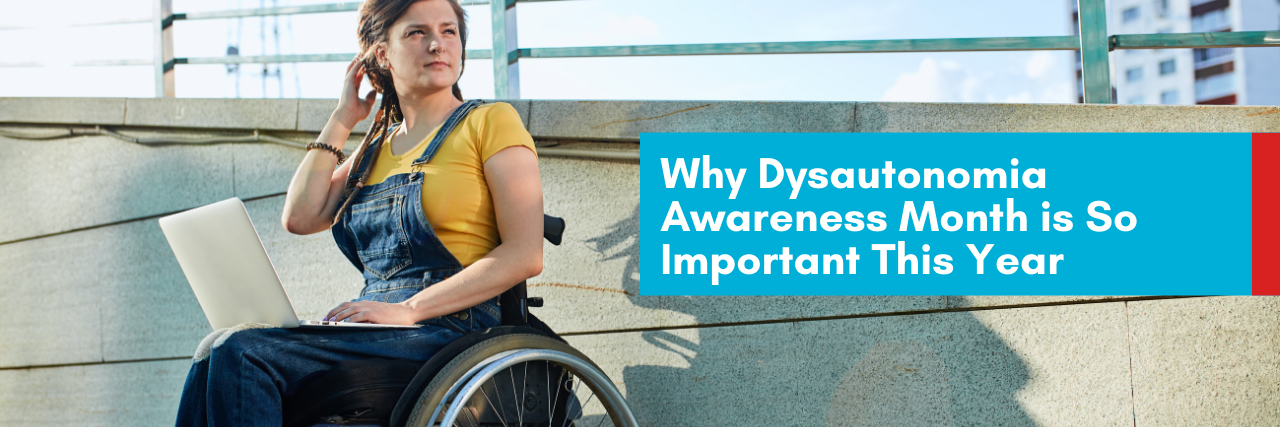Why Dysautonomia Awareness Month is So Important This Year
I am someone who always knows where the nearest seat and air conditioning is located. It used to be a major source of stress for me, but now this superpower is more instinctual. I may look normal on the outside, but I am often struggling with a high heart rate and fatigue from my nervous system trying to thwart gravity. Note to the public: gravity always wins.
I live with postural orthostatic tachycardia syndrome, or POTS, a form of dysautonomia. Dysautonomia is an umbrella term to describe conditions that can result from a wonky autonomic nervous system. In my case, my nervous system doesn’t like being upright. Normally, your autonomic nervous performs a lot of great feats to keep your blood circulating normally when you stand up and gravity tries to pull everything to your feet. Your veins narrow and your blood pressure increases a little bit — all so that your brain can continue to get the oxygen it needs from your blood. In my case, my nervous system doesn’t want to be part of this great, coordinated concert and blood pools in my legs and feet. Trust me, it doesn’t look pretty. I used to be a homeschool teacher and one of my students kept saying my feet made me look like a vampire. Yup. He wasn’t wrong though.
As a result of this wonkiness, I’m left with a high heart rate, adrenaline surges and fatigue, among a myriad of other wild, very unpredictable symptoms. The weirdest one? My pupils are always extremely dilated. Not the best look, especially when parents would get concerned about my “recreational activities” in middle school.
I wasn’t always easy going with my experience with POTS and some days, I am very done with living with an incurable chronic illness. Thank goodness cookies and Sarah J Maas exist. Any form of dysautonomia can be debilitating, and while I don’t usually refer to myself as “sick” anymore, I am disabled. Although I’ve had low blood pressure my whole life, my journey with POTS didn’t really begin until after college. In 2017, I had several mild to moderate viral illnesses and finally, my body seemed to say that’s it, and I began experiencing severe POTS symptoms. Who knew a heart could accelerate from 70 to 180+ BPM in less than 30 seconds just by standing up!
So why talk about POTS? October is dysautonomia awareness month, which focuses on advocacy for research and awareness. I am a huge advocate for dysautonomia education and research advances. An estimated 1-3 million people have POTS in the U.S. alone — that’s more than the number of people living with Celiac disease. It’s important to note that the vast majority of people who are diagnosed with dysautonomia are young women, a population that often struggles with finding the correct diagnosis and treatment for other “invisible” illnesses. Dysautonomia is most often misdiagnosed as anxiety and many physicians are unaware of dysautonomia. Both of these factors heavily influence the average 6-year diagnosis time for someone struggling with symptoms.
This year, dysautonomia awareness month is different. In the past, whenever I would go to a new health care provider or the ER, doctors wouldn’t believe I actually was diagnosed with POTS at first. They would root through my records, seeking confirmation from my cardiologist, luckily one of the few leaders in POTS treatment. Looking at charts isn’t so simple because POTS doesn’t even have a medical code (ICD-10), a situation Dysautonomia International is advocating to be remedied shortly, so they’d have to read through years of notes.
Talking about POTS has changed dramatically with the COVID-19 pandemic. While there are many potential “causes” of POTS, a lot of people have post-infectious POTS like me. Viral illnesses can cause changes in the body that impact the nervous system, resulting in fatigue, high heart rates, chest pain, low blood pressure, feeling out of breath, etc. Sound familiar? You guessed it — COVID-19 long-haul syndrome.
Because of advocacy efforts from the dysautonomia community at-large, people struggling with COVID-19 long-haul syndrome have more resources available to them and hopefully have a shorter time to diagnosis than before. Although I would never wish any form of dysautonomia on someone, the increased cases of COVID-19 long-haul syndrome give me hope for advancements in medicine for dysautonomic conditions. One of the hardest aspects of treating POTS and other forms of dysautonomia is identifying the root cause of the syndrome. Research on COVID-19 long-haulers have already shown incredible potential advancements in our understanding of these conditions.
If you’ve been suspecting COVID-19 long-haul syndrome, know that you’re not alone. I know that feeling like your body is out of control can be incredibly scary but know that it can get better. The Mighty has a community dedicated to COVID-19 long-haulers, so that you can get the support you need from people who get it. For anyone seeking more information about what it’s like to live with POTS, you can check out my personal blog, Chronically Salty.
And if you don’t have any COVID-19 long-haul symptoms or dysautonomia, the best thing you can do is get the coronavirus vaccine to help protect yourself and your community, as well as help advocate for dysautonomia awareness month. There are a lot of people struggling with these invisible symptoms and just acknowledging their journey can make an incredible difference.

